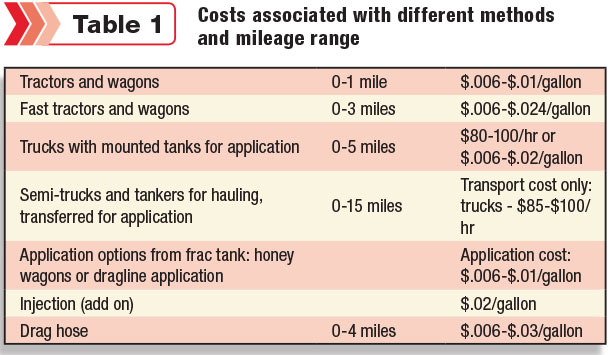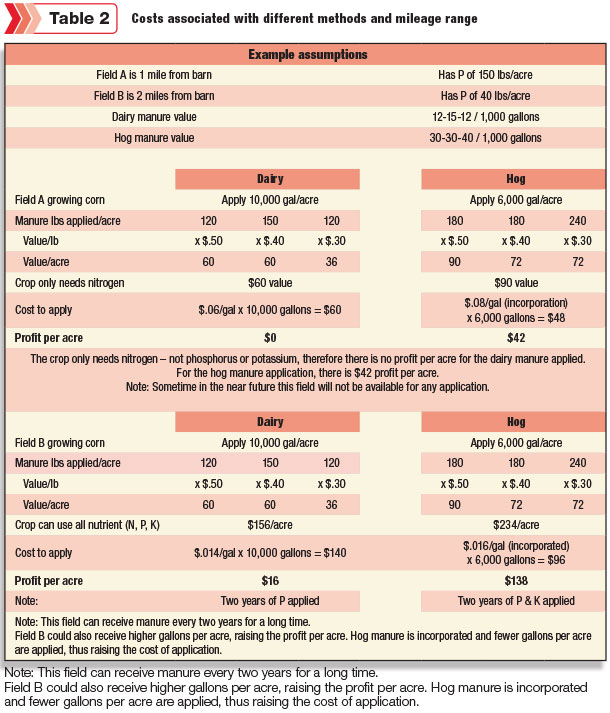The first consideration about manure is to change the mindset of manure being a waste product to being a resource. With that assumption, there are multiple variables that influence manure transportation and application considerations.
When I am asked by a producer, “How much will it cost?” the answer is, “It depends.” Specifically, it depends on where the farm needs the product, when the product is moved and how the customer wants it applied.
Manure is not a waste unless it is applied where it is not needed for plant growth, just like a morning glory flower. I remember telling my “city grandmother” that she had “weeds” in her garden (morning glories).
Morning glories in the garden are beautiful flowers – but in the cornfield, not so much. Manure is the same – when applied where it’s not needed, it is a wasted resource.
Some of the variables that influence the cost are outlined in Table 1. The type of equipment needed, distance to field and tradition (past practices) are the substantial considerations that will determine the final cost.

The type of equipment used for transportation and application affects cost. Tractors and wagons are not optimal for transporting long distances (more than 1 mile). Semi-trucks and tankers are more efficient for longer distances.
Specific to application, there are several specific factors that influence the per-gallon cost. Some of these include fuel provided, pump provided or rented and whether or not there are set-up fees and move-in costs.
Transporting manure to remote fields requires the proper equipment, but application to the field also requires the appropriate means. Moving manure from a frac tank into a honey wagon may be best suited for a small, irregular-shaped field.
Utilizing a frac tank and dedicated tractors with a dragline for dairy manure application may be best used in a large field. The transportation and application costs are combined to determine the overall cost to move manure to an optimal location.
In addition to the earlier identified variables, there are situational components that will influence processes, operations and, thus, costs. Questions I ask the farmer include:
- How far to the fields?
- What is the field size and shape?
- Are there streams or wet spots? Houses or neighboring structures?
- What has been the level of communication with neighbors, other producers and other stakeholders?
I also assess my customer’s personality. Pleasant to work with or difficult? I take the time to assess the farmer’s reputation and previous interaction with neighbors. Depending on the information the customer provides, I further assess how far the customer is from home, what time it will take to move in and if I will incur hotel costs.
Depending on the information provided by the customer, I will be able to determine what equipment is needed – two trucks or four trucks, types of tractors and the number of gallons to move. In addition, I map the route to the application site and make notations of access (drive-through or back-in necessary), road width and traffic patterns, stop signs or stoplights.
 During my information gathering, I also determine if I need to provide fuel or if the customer will provide it. I specifically outline customer expectations, paperwork that is required and payment terms.
During my information gathering, I also determine if I need to provide fuel or if the customer will provide it. I specifically outline customer expectations, paperwork that is required and payment terms.
Some details I have learned to ascertain include local traditions, nuances and preferences to better communicate how our operation will not conflict in that environment. I also ask for any GPS information that has already been mapped to better help with application. All of these pieces have costs or savings, thus influencing the overall cost.
So how or why do we move manure 5 miles? We are required, we need the acres, and the remote acres need phosphorus.
There are multiple variables and scenarios that impact the cost of manure application. The basic assumption of manure being a resource, rather than a waste product, influences all aspects of manure utilization. Multiple influences and processes impact the transportation and application of this resource.
The type of livestock operation, acres under control of the operation, the size of the operation and the location of the fields will influence how manure will be utilized.
We have been very successful in building partnerships with neighbors to meet both the needs of the livestock operation and the nearby grain operations. Utilizing manure as a resource is another way agriculture is the original recycler. PD
This article is based on the rules, regulations, traditions and environment of Ohio.
Eric Dresbach is the owner of WD Farms, a manure application and trucking company. This article is based on a presentation by Dresbach at the 2015 North American Manure Expo held in Pennsylvania.
PHOTO: Some equipment used to transport and apply manure. Photo courtesy Eric Dresbach.
Eric Dresbach is the president of WD Farms Inc. Email Eric Dresbach.





